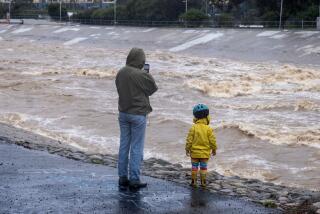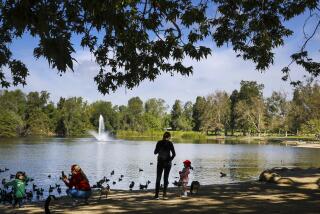How L.A. students will — or won’t — experience Monday’s solar eclipse
On Monday morning, as the moon passes directly in front of the sun, more than 2,000 students at the Sherman Oaks Center for Enriched Studies, one of L.A. Unified’s most sought-after magnet schools, will get to view the eclipse in person through NASA-approved glasses.
Another 500 students at Leland Street Elementary School in San Pedro will do the same.
But many public-school students in Los Angeles will miss the chance to experience the eclipse live. They will be kept almost entirely indoors as they would in a situation of extreme heat, exceptionally harmful air pollution or a security threat near campus.
In a memo sent to principals Thursday, Los Angeles Unified School District officials said that for safety reasons, students watching the eclipse outdoors must have signed permission slips and wear NASA-approved glasses. Any children without these will have to remain indoors from 9 a.m. to noon. Other school districts have taken similar precautions.
“We don’t want to be overbearing. We don’t want to quell the excitement around the event of Monday because we know it’s historic, we may never see this again in our lifetime,” said Diane Pappas, L.A. Unified’s chief executive of district operations and digital innovation. “But I don’t want children going blind because they’re not supervised and exercising proper precaution.”
A day after the first memo went out, in response to criticism, the district sent a second email to principals, saying that teachers are allowed to make pinhole cameras with their students — a do-it-yourself way to watch the eclipse without staring at the sun. But with only days until the eclipse, signed permission slips remain a must-have. Many students are expected to have to watch the event inside classrooms, via NASA’s live stream.
Some parents said they would keep their children home on Monday to watch from their backyards. But in L.A. Unified, where about 75% of students are eligible for free or reduced lunch and come from families that struggle to make ends meet, it’s unlikely that many will have been able to snag pairs of the special eclipse glasses at the last minute.
The problem, known to anyone scrambling to buy the glasses, is that high demand means high prices. Many of the most reputable sellers have sold out.
Those public libraries that have been giving away glasses have been overwhelmed. “Most libraries have already given away their allotment of glasses,” warned the website of the STAR Library Network in Boulder, Colo., which supports libraries across the nation in providing programming in science, technology, engineering and math.
There are more than 514,000 students in L.A. Unified. District officials said they left it up to principals to buy glasses or solicit donations of them for the students in their schools.
Many schools were caught less than fully prepared, both in terms of organizing the learning opportunity and sorting out the safety protections.
The Archdiocese of Los Angeles said it had not distributed any particular materials or precautions, leaving such decisions up to individual schools.
Glendale Unified School District informed parents about the eclipse by both letter and automated phone messages — and posted information online. The district’s plan also included putting translations of the information online in Armenian, Korean and Spanish. These were posted midafternoon on Friday.
Parents and teachers at one South Pasadena school began preparing weeks ago.
David Kubela, principal of South Pasadena Middle School, said many of his students have parents who work at NASA’s Jet Propulsion Laboratory and the University of Southern California. Over the summer, they worked with the school’s science teachers to make plans.
They bought enough glasses for the school’s more than 1,100 students. They sent forms to parents letting them opt out of the outdoor viewing.
“It’s such a wonderful real-world opportunity to see science in action,” Kubela said.
Long Beach Unified isn’t in session yet — except for two schools on an early-start calendar. The principal at one of them, Sato Academy of Mathematics and Science, said she has been thinking about the eclipse since last spring. That’s when a family wanted an excused absence for their child’s upcoming trip to go watch it.
Principal Mona Merlo decided it would be unacceptable for the rest of her students to miss out.
“We had to do this,” said Merlo, who remembers watching a solar eclipse through a pinhole viewer as a fourth-grader in South Dakota.
On Friday, every student at Sato made a pinhole viewer and each class watched a short film on how a solar eclipse can lead to eye damage. It included a testimonial from a man with permanent vision loss.
Merlo looked for eclipse glasses but found every store sold out. She will, however, have four pairs for students in each class to share, courtesy of a science teacher from a different school, whose own class won’t be in session.
Her plan for Monday is to hold a 20-minute fire drill, an ordinary back-to-school ritual, with one big exception: The drill will take place during peak eclipse viewing time.
Twitter: @annamphillips
More to Read
Start your day right
Sign up for Essential California for news, features and recommendations from the L.A. Times and beyond in your inbox six days a week.
You may occasionally receive promotional content from the Los Angeles Times.








